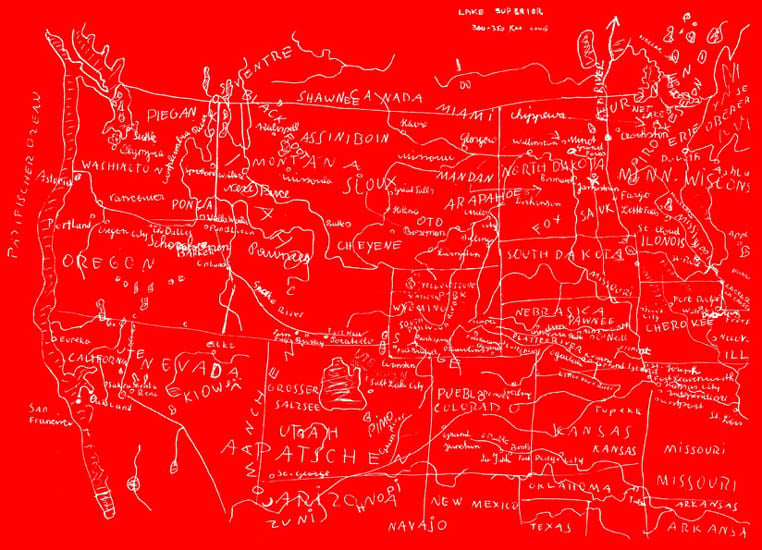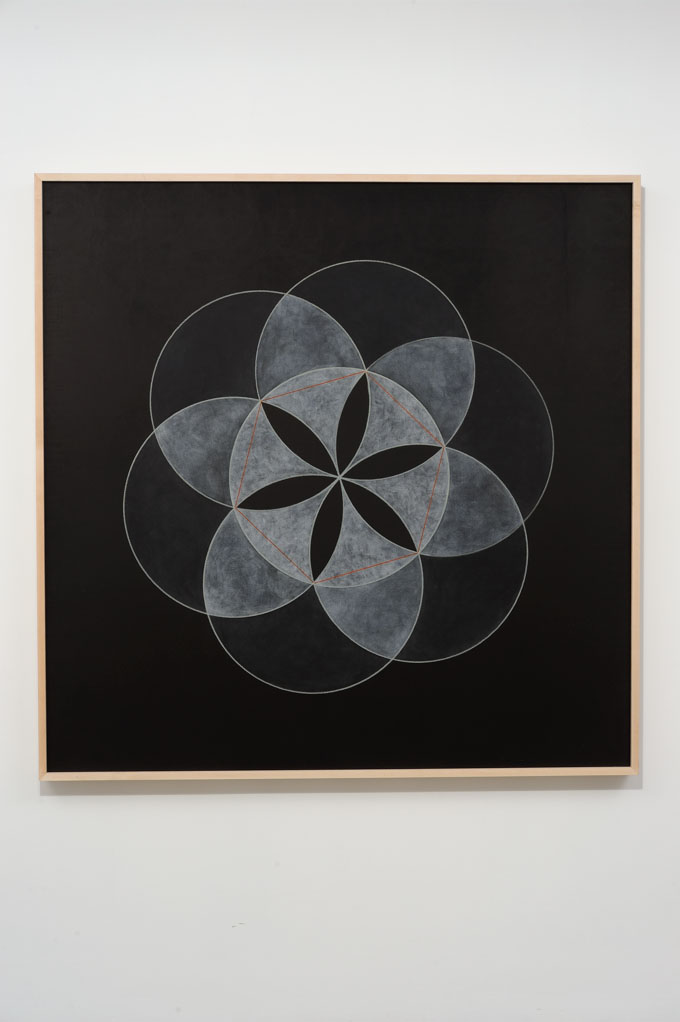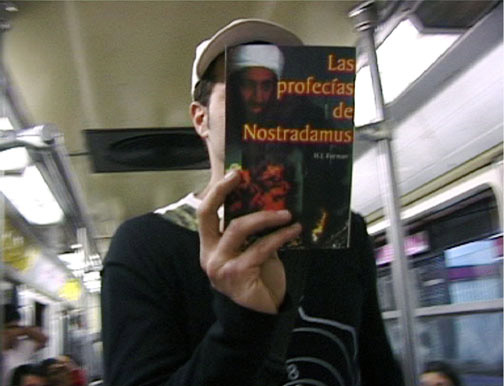
© » KADIST
Frieda Toranzo Jaeger
This triptych is based on a Tesla whose interior the artist customized on the Tesla website. The width of the work when the panels are closed is the exact width of a Tesla, thus one designed to hold two bodies side by side. In Mexico City the car is used as a social space and, for young people, one not controlled by parents.

© » KADIST
Peter Friedl
Peter Friedl’s projects place aesthetic questions within an expanded field that takes into account the social, political and philosophical context. This textile piece quotes and diverts a flag with a red background and the central star of the Kurdistan National Liberation Front (ERNK, a military organization linked to PKK, founded in 1985 and disbanded in 2000), and not the national flag of Kurdistan. The artist became interested as from 1994, when the town of Lice was destroyed by the Turkish army and the PKK was expelled from Germany.

© » KADIST
Peter Friedl
Drawing & Print (Drawing & Print)
Map 1969-2005, a poster glued on the wall, questions space in its relation to geography. On a red background, a free-hand drawing in white refers to the aesthetics of maps. Map 1969-2005 is not an accurate map of the United States, but one that combines mapping, overlaps and merges diverse elements: Oregon, Lake Superior, San Francisco, Cheyenne, Missouri, Zuni, Navajo, Texas, Shawee, Colorado, Piegan, Canada, Miami, etc.

© » KADIST
Frida Orupabo
The archival images used by Frida Orupabo in her collages trace stereotyped representations of race, gender, sexuality and violence. Her works are developed through a process of decontextualization of such imagery, layering and recomposing, playing with new narratives. In this work she focuses on memory and what might be triggered in the viewer.

© » KADIST
Christopher Badger
Drowned Wood Standing Coiled (2011) consists of two sculptures, inextricably linked. In each, pieces of driftwood are bundled together vertically and entwined with rope, which cascades to the floor in a tightly wound coil. Placed side by side on the ground, these sculptures anthropomorphize into partners who are literally and figuratively bound.

© » KADIST
Javier Castro
In the film La Edad de Oro (The Golden Age) Javier Castro asks several children to describe what they want to be when they grow up and what their best career option is in Cuba. Their responses are telling: some hopeful or playful in nature as one would expect, and others crudely revealing the harsh reality that the children perceive. The work takes its title from a children’s magazine produced by José Martí in 1889, during the years leading to the Cuban War of Independence from Spain in which Marti lost his life.

© » KADIST
Javier Castro
In the video Negro sobre Negro (Black on Black) all we see is a completely black screen on a monitor that is recessed into a wall, also painted black. Gradually, the face of a man becomes visible as he steps out of the darkness and closer to the camera. As suggested by Castro, the color of this man’s skin allows him to pass unnoticed perhaps literally, but also metaphorically as he alludes with certain humor to the iconic work Black Square by Suprematist artist Kazimir Malevich, often referred to as the “zero point of painting” in Western art-historical discourses.

© » KADIST
Javier Castro
In the video Blanco sobre Blanco (White on White) , we see a white man appearing in a white screen embedded into a white wall— alluding to Malevich’s White on White series. Analogously, in Castro’s related work Negro sobre Negro (Black on Black) all we see is a completely black screen on a monitor that is recessed into a wall, also painted black. Gradually, the face of a man becomes visible as he steps out of the darkness and closer to the camera.

© » KADIST
Christopher Badger
In mathematics, the so-called geometric problems of antiquity are shapes that elude the classical tools of an unmarked straightedge and compass. In Geometric Construction of Antiquity, 6 (2011), Badger doggedly sets out to represent one such form. Each of six circles grazes its opposite and crosses the other five.

© » KADIST
Christoph Draeger
In his performative action Subterranean Doomsday Vendor , Draeger positions himself in the subway system of Mexico City, as part of the common occurrence of bootleg media vendors. His contribution lies in dissemination of prophecy as he tests the public’s reactions to the types of content and media which can be circulated in such common spaces.

© » KADIST
Fred Wilson
Fred Wilson’s flag paintings document the 20th century history of African people, indexing the period of liberation from colonialism. As the majority of African flags were created during the 1950s and 60s, they were intended to reflect a so-called ‘modern’ aesthetic and ideology. Many African flags maintain the typical flag tropes such as stripes, stars, birds, and blocks of primary and secondary colors; green to represent the land; blue to symbolize the ocean or sky; and red to recall the violence that occured in the pursuit of liberty.

© » KADIST
Javier M. Rodríguez
Javier M. Rodriguez’s Going Round and Round in a Line ST (12m) is a sculptural composition made of the simplest materials—a single tape measure and metal rivets. The rivets lock the tape measure in its contorted shape, bending in angles to create a geometric abstraction. The piece hangs simply from the ceiling, at times rotating around, its shape changing with our point of view.

© » KADIST
Fredi Casco
Drawing & Print (Drawing & Print)
Pascua Dolorosa (Painful Easter) by Fredi Casco is a series of drawings made on old worksheets documenting land surfaces in Caapucú, a forest exploitation area where one of the most violent episodes of the repression of Stroessner’s dictatorship took place in 1976, and during which peasants accused of belonging to insurgent movements were kidnapped, tortured and many of them killed. In 2009, human bone remains were found in the Caapucú region during ground measurement work. These works reveal the tension between a cold and positivistic approach to landscape as put on record in the legal papers, the poignant use of violence as inscribed into the land, and a ghostly invocation of the power of resistance.

© » KADIST
María Isabel Rueda
The Real. Retrato de Norman Mejía. (The Real. A Portrait of Norman Mejía.)
Javier Castro
Javier Castro was born in the in the neighbourhood of San Isidro in the heart of Habana Vieja, Cuba, where he lives and works...
Christopher Badger
Christopher Badger begins with a root fascination—a shape, a landscape, or a sound—and then pursues it methodically to its logical, and usually open-ended, conclusion...
Peter Friedl
Many of the projects of Peter Friedl, in their heterogeneous medium and style, function as intersection points between countless lines of thought and reference, creating a vast didactic network where dialogues simultaneously merge with critical logic and narrative...
Christoph Draeger
Swiss artist Christoph Draeger lives and works between Vienna and NY...
Frieda Toranzo Jaeger
Many of Frieda Toranzo Jaeger’s works take the triptych format, employed by artists over many centuries to represent religious devotion...
Fred Wilson
- location: Bronx, United States
- year born: 1954
- gender: male
- nationality: American
Fredi Casco
Working with a variety of media such as drawing, painting and photography Fredi Casco frequently incorporates original documents and archives as a medium and support of his work in order to bring to light specific episodes of Paraguayan political history, particularly events that took place during the time of Alfredo Stroessner’s long dictatorship (1954 to 1989)...
Frida Orupabo
A central element of Frida Orupabo’s practice is her digital archive, storing images from both the media and from her personal life on her Instagram account, later transforming them into analogue collages...
-
2000-2009
Peter Friedl
2001Peter Friedl’s projects place aesthetic questions within an expanded field that takes into account the social, political and philosophical context...
Peter Friedl
Drawing & Print
2005(Drawing & Print) Map 1969-2005, a poster glued on the wall, questions space in its relation to geography...
Christoph Draeger
2006In his performative action Subterranean Doomsday Vendor , Draeger positions himself in the subway system of Mexico City, as part of the common occurrence of bootleg media vendors...
Javier Castro
2008In the video Negro sobre Negro (Black on Black) all we see is a completely black screen on a monitor that is recessed into a wall, also painted black...
Fred Wilson
2009Fred Wilson’s flag paintings document the 20th century history of African people, indexing the period of liberation from colonialism...
-
2010-2019
Christopher Badger
2011Drowned Wood Standing Coiled (2011) consists of two sculptures, inextricably linked...
Christopher Badger
2011In mathematics, the so-called geometric problems of antiquity are shapes that elude the classical tools of an unmarked straightedge and compass...
Javier Castro
2012In the film La Edad de Oro (The Golden Age) Javier Castro asks several children to describe what they want to be when they grow up and what their best career option is in Cuba...
Javier Castro
2014In the video Blanco sobre Blanco (White on White) , we see a white man appearing in a white screen embedded into a white wall— alluding to Malevich’s White on White series...
Frieda Toranzo Jaeger
2017This triptych is based on a Tesla whose interior the artist customized on the Tesla website...
Fredi Casco
Drawing & Print
2017(Drawing & Print) Pascua Dolorosa (Painful Easter) by Fredi Casco is a series of drawings made on old worksheets documenting land surfaces in Caapucú, a forest exploitation area where one of the most violent episodes of the repression of Stroessner’s dictatorship took place in 1976, and during which peasants accused of belonging to insurgent movements were kidnapped, tortured and many of them killed...
Frida Orupabo
2018The archival images used by Frida Orupabo in her collages trace stereotyped representations of race, gender, sexuality and violence...